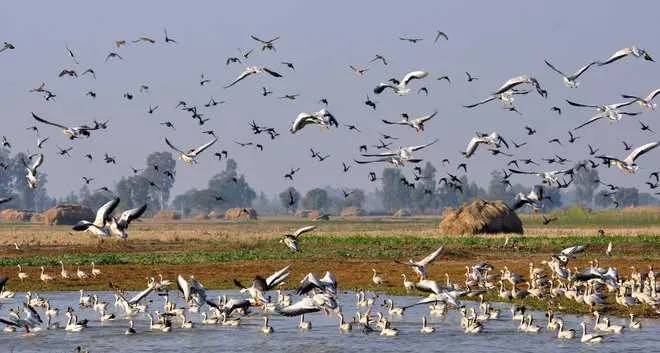Migratory Birds Paint the Skies with Color as They Visit Kashmir Wetlands

Srinagar, Dec 7 (NationPress) The evening chorus in the skies as a multitude of migratory birds begin to alight on the water surface signals that these feathered travelers are honoring their annual visit to the Kashmir Valley.
The colorful spectacle on the water at the Hokersar bird reserve near Srinagar clearly illustrates that nature is the supreme artist.
Among the prominent species of migratory birds arriving in the Valley are Teals, Mallards, Coots, Wigeons, shovelers, Brahminy ducks, Pochards, Pintails, Tufted ducks, Shelducks, and Greylag geese, migrating from regions such as Russian Siberia, China, Japan, Eastern Europe, and the Philippines.
These avian guests arrive to spend the winter in the tranquil surroundings of Kashmir, escaping the harsh winters of their summer habitats.
Regional wildlife warden, Tawheed Ahmad Deva, informed IANS that while the number of migratory birds is currently lower due to a prolonged dry spell, the bird count is anticipated to increase within the next 10 to 20 days as winter weather brings rain and snow.
“For instance, if we expected 100 bird species by now, we currently have about 60 species in our wetlands. This is likely to improve as precipitation occurs in the coming days,” the wildlife warden explained.
Last year, official statistics indicated that the Valley hosted between 800,000 and 1.2 million migratory birds, while in the 2021-2022 season, the count ranged from 1.1 million to 1.2 million.
In addition to the migratory birds that make Kashmir’s wetlands their winter refuge, certain species known as ‘birds of passage’ briefly halt in the Valley during early winter and late spring before continuing to the Indian plains.
Examples include the Sandhill cranes and Cormorants, which spend only a few weeks in the Valley on their migratory routes.
The first arrivals include Coots and Teals, while Greylag geese typically arrive in the first week of December.
Notable migratory bird reserves in Kashmir include Hokersar, Chatlam, Shallabugh, and Hygam, with many birds also finding refuge in Wular Lake, Dal Lake, and various other water bodies in the Valley.
Bird poaching remains a significant threat that the wildlife protection department is actively combatting.
“We operate control rooms to monitor these bird reserves and prevent poaching. Migratory birds not only beautify our environment but also serve as indicators of our ecological health,” the wildlife warden stated.
Witnessing the migratory birds soar gracefully across the sky, with the eldest bird leading the formation, is a breathtaking sight. Should the leader fall ill or perish, the next in line assumes command.
“These birds are guided by instinct as they travel thousands of miles with remarkable accuracy. The journey to their winter habitats is so demanding that a bird can lose more than half of its body weight during the flight from summer to winter homes,” another wildlife protection officer remarked.
It is a cherished tradition in Kashmir for elders to narrate tales of migratory birds to their children and grandchildren.
During the long winter nights, children in remote villages gather around their parents and grandparents to listen to these ‘Duck tales’.
It is hoped that the legacy of these migratory bird stories will be passed down through generations, fostering awareness about the health of local water bodies and their impact on human life.









